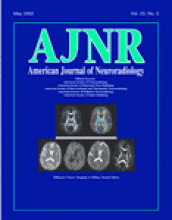In this issue of the AJNR, Roberts et al describe the dynamic contrast-enhanced CT findings in two patients with metastatic brain tumors. Specifically, the authors demonstrate the feasibility of constructing quantitative maps of the microvascular permeability surface area product, as well as more familiar blood volume and flow maps, by using CT datasets. Such maps may provide a numerical estimate for the degree of local disruption of the blood-brain barrier. Because permeability measurements are dependent on the molecular structure of the tracer used for imaging (ie, nonionic iodinated contrast material for CT and gadolinium-based agents for MR imaging), focal variations in permeability were noted between the CT and MR maps in one patient; the CT blood volume maps, however, correlated well with their MR counterparts.
The article by Roberts et al is a well-written report on a novel and timely topic—that of brain-tumor permeability mapping by using CT tracer-kinetic techniques. As with dynamic blood volume imaging, such mapping has the potential to assist in the grading of brain tumors, prediction of outcomes, guidance of stereotactic biopsy, monitoring of treatment responses, and evaluation of anti–angiogenesis agents (as surrogate markers in clinical trials). In distinction to the more thoroughly studied first-pass tracer-kinetic models commonly used to create MR and CT perfusion maps, the method described by Roberts et al uses delayed imaging; the total acquisition time was 5½ minutes, with a radiation dose roughly twice that of a routine nonenhanced head CT examination. Body imagers have applied related methods to study liver and prostate tumors; perhaps this articles will provide an impetus for similar studies by neuroradiologists.
Unlike MR perfusion techniques, CT currently has limited coverage and requires the use of both iodinated contrast material and ionizing radiation. CT, however, can provide convenient, high-resolution, low-cost, and truly quantitative maps of cerebral blood flow (CBF), cerebral blood volume (CBV), mean transit time (MTT), and permeability surface area (PS) product. Drawbacks to MR perfusion imaging include contraindications to imaging in some patients, as well as the confounding effects of susceptibility artifact on image quality and flow quantification.
Abbreviations for perfusion imaging techniques that have appeared in the literature include the following: DCEMR/CT, which is defined as dynamic contrast-enhanced MR or CT imaging (as used in the manuscript by Roberts et al); HI, defined as hemodynamic imaging; PWMR/CT, defined as perfusion-weighted MR imaging or CT; pMRI/CT, defined as perfusion MR imaging or CT; and MRP and CTP, which are generic terms for MR and CT perfusion imaging, respectively—to name just a few. Such varied terminology is not only confusing but also possibly misleading. For example, many articles that describe an MR diffusion-perfusion mismatch in acute stroke have not explicitly clarified that they refer to only arrival time maps, and not to CBF, CBV, or even MTT maps; this distinction is important and sometimes critical in the presence of a fixed carotid artery occlusion. Also, dynamic first-pass MR perfusion imaging of tumors can be performed by using either gradient-echo (common) or spin-echo (uncommon) pulse sequences; each have different implications for the dosage of gadolinium-based contrast agent and the sensitivity for the detection of large-capacitance vessels. Moreover, alternative, non–first pass methods for perfusion CT are available; these include CT perfused blood-volume imaging (CT-PBV), in which CBV-weighted images of the entire brain are obtained—simultaneously with CT angiographic (CTA) images of the complete neurovascular system—by using the same, approximately steady-state administration of a bolus of contrast agent (1,2). Because of their generality, in addition to their lack of standardization, the acronyms noted earlier fail to adequately distinguish between the various forms of perfusion imaging.
This profusion of perfusion abbreviations suggests that it is time for the neuroradiology community to establish a standardized nomenclature. I would like to open the discussion by proposing the following scheme; perhaps this issue will not prove to be as contentious as the great turn-of-the-millennium CT debates about helical versus spiral terminology, or single versus multislice pitch definitions (3). CTP and MRP are probably appropriate generic abbreviations to use when one is referring to CT or MR perfusion imaging broadly and nonspecifically, just as CTA is a widely accepted acronym for CT angiography. When greater detail regarding the type of perfusion imaging is required, perfusion maps could be specified by using a two-letter prefix to define the modality and a three-letter suffix to describe the parameter being measured. For example, CT-PBV can be used to indicate CT perfused blood volume maps, and MR-PS can be used for MR permeability surface area maps. When the context is insufficient to discriminate between related maps, an extra lowercase qualifier might be judiciously considered. For example, quantitative scans could be characterized by the addition of the letter “q,” as in CT-qCBF for quantitative dynamic first-pass CT perfusion maps, as opposed to CT-MTT for MTT maps constructed by using qualitative or unspecified methods. Similarly, although gradient-echo is the default mode in performing MR-CBV, spin-echo acquisitions could be specified as MR-seCBV.
Such a scheme, if adopted, has the potential not only to reduce the confusion caused by the increasing number of CT and MR perfusion applications but also encourage physicians to become more familiar with the details of these techniques.
- Copyright © American Society of Neuroradiology







